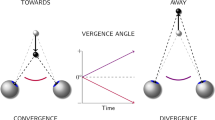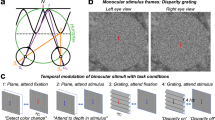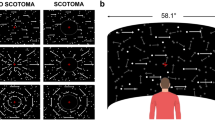Abstract
ARE two eyes needed for judging direction of self-motion? Traditional analyses stress that the pattern of optic flow in one eye is sufficient1–5. The main difficulty is how to deal with the eye or head rotation. Extraretinal signals help6–8, but humans can also discount the effect of rotation purely on the basis of monocular flow6,7,9–12 provided the scene contains depth6,9,10. Depth differences give rise to changing binocular disparities when the observer moves. These disparities are ignored in monocular theories of judgements of heading. Using computer generated displays, we investigated whether stereoscopic presentation improves heading judgements for conditions that pose problems to the monocular observer. We found that adding disparities to simulated ego-motion through a cloud of dots made heading judgements up to four times more tolerant to motion noise. The same improvement was found when the disparities specify the initial distances throughout the motion sequence. We conclude that binocular disparities improve judgements of heading by imposing a depth order on the elements of the scene, not because they provide additional information on the elements' motion in depth.
This is a preview of subscription content, access via your institution
Access options
Subscribe to this journal
Receive 51 print issues and online access
$199.00 per year
only $3.90 per issue
Buy this article
- Purchase on Springer Link
- Instant access to full article PDF
Prices may be subject to local taxes which are calculated during checkout
Similar content being viewed by others
References
Gibson, J. J. Perception of the Visual World (Houghton Mifflin. Boston, 1950).
Longuett-Higgins, H. C. & Prazdny, K. Proc. R. Soc. B208, 385–397 (1980).
Rieger, J. H. & Lawton, D. T. J. opt. Soc. Am. A2, 354–359 (1985).
Koenderink, J. J. & Van Doorn, J. A. Biol. Cybern. 56, 247–254 (1987).
Heeger, D. J. & Jepson, A. Neural Comp. 2, 129–137 (1990).
Warren, W. H. & Hannon, D. J. Nature 336, 162–163 (1988).
van den Berg, A, V. Vision Res. 32, 1285–1296 (1992).
Royden, C. S., Banks, M. S. & Croweli, J. A. Nature 360, 583–585 (1992).
Warren, W. H. & Hannon, D. J. J. opt. Soc. Am. A7, 160–169 (1990).
Rieger, J. H. & Toet, L. Biol. Cybernet. 52, 377–381 (1985).
van den Berg, A. V. Nature 365, 497–498 (1993).
van den Berg, A. V. & Brenner, E. Vision Res. 34, 2153–2167 (1994).
Author information
Authors and Affiliations
Rights and permissions
About this article
Cite this article
van den Berg, A., Brenner, E. Why two eyes are better than one for judgements of heading. Nature 371, 700–702 (1994). https://doi.org/10.1038/371700a0
Received:
Accepted:
Issue Date:
DOI: https://doi.org/10.1038/371700a0
This article is cited by
-
Advantage of binocularity in the presence of external visual noise
Graefe's Archive for Clinical and Experimental Ophthalmology (2010)
-
An algorithmic model of heading perception
Biological Cybernetics (2005)
Comments
By submitting a comment you agree to abide by our Terms and Community Guidelines. If you find something abusive or that does not comply with our terms or guidelines please flag it as inappropriate.



